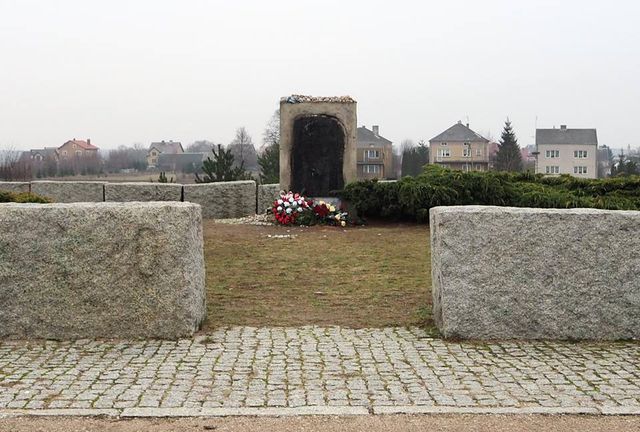Clara Weiss
The Polish government in Warsaw is calling for a revision of history aimed at downplaying Poland’s involvement in anti-Semitic crimes. The centrepiece of the right-wing conservative government’s campaign is the pogrom in Jedwabne, a village in the northeast of Poland. There, in the summer of 1941, Polish anti-Semites killed more than 350 Jews with the agreement of German occupying forces.
Education minister Anna Zalewska asserted in a television interview she was not clear who was responsible for the pogrom in Jedwabne, as well as the pogrom in Kielce in the summer of 1946. Shortly before, Jarosław Szarek, the new director of the Institute for National Memory, which is under government control, denied the responsibility of Polish nationalists for the Jedwabne pogrom.
Soon afterwards, right-wing Lublin-based historian Ewa Kurek announced plans to collect signatures over the summer for a petition calling for the exhumation of the remains of the victims of the Jedwabne pogrom. The mayor of Jedwabne, Michael Chajewski, backed the exhumations, telling theGazeta Wyborcza, “Yes, I would do that. It is necessary to clarify how many were killed and by whom, in order to overcome doubts.”
The exhumation of the victims’ remains was already ordered in 2001 under the presidency of Lech Kaczynski. But it was never implemented, above all due to worldwide protests. The Jewish religion prohibits exhumations, which are considered to be a desecration of the dead. Representatives of Jewish organisations in Poland and internationally repeatedly spoke out against the exhumations.
Prior to the Second World War, the Jewish community in Poland was the largest in Europe, numbering 3.5 million. In virtually every Polish city, the Jewish population amounted to between 30 and 50 percent of the total, and in some even more. In the country as a whole, which was still dominated by agricultural production, the Jewish community amounted to 10 percent of the entire population.
During the Second World War, the Nazis turned occupied Poland into the main location for the extermination of European Jewry. All six concentration camps (Auschwitz, Treblinka, Chełmno, Sobibór, Majdanek and Bełżec) were located on current Polish territory. Only around 350,000 Polish Jews survived the war, most of them in the Soviet Union. At least 1.5 million Jews from other European countries were transported to camps in Poland and murdered there.
Polish anti-Semites also carried out pogroms against the Jewish population prior to, during and after the war. The Jedwabne pogrom, which occurred soon after the Nazi invasion of the Soviet Union on June 22, 1941, is the most well known of these. In 2000, the Polish-American sociologist Jan Tomasz Gross published a book on the pogrom titled “Neighbours,” unleashing the most wide-ranging debate on historical and political questions since 1989.
Gross played an important role in the student protests of March 1968 in Poland and then emigrated in 1969 with his family as a result of the Stalinist regime’s anti-Semitic campaign. In his book, he utilised generalisations and an ahistorical method recalling that employed by Daniel Goldhagen in his book Hitler’s Willing Executioners. Like Goldhagen, Gross, whose writings are riddled with anti-communism, opposes a class analysis of fascism and anti-Semitism. Instead, he makes use of national abstractions and declares “the Poles as a nation” to be “perpetrators.”
By contrast, he says nothing about the history of the Polish workers’ movement, which in the 1930s led a struggle against the anti-Semitism of the government and extreme right-wing forces. Gross paid just as little attention to the crimes of Stalinism, which made possible Hitler’s victory in Germany, beheaded the socialist movement in the 1930s and prepared the way for the Second World War with the Stalin-Hitler pact.
However, in contrast to the claims of the Polish government, there is no historical doubt about the responsibility of Polish anti-Semites for the Jedwabne and Kielce pogroms. A comprehensive investigation by the Institute of National Memory (IPN), which was commissioned by the government in the wake of the publication of Gross’s book, came to the conclusion that at least 340 Jews were killed in the summer of 1941, broadly agreeing with Gross’s figures.
Many victims were burnt alive in the village’s church. Research by historian Anna Bykont confirmed the findings by the IPN and Gross. According to Bykont, the pogrom was carried out by nationalist elites in the village.
 The memorial for the victims of the Jedwabne pogrom
The memorial for the victims of the Jedwabne pogrom
With over 40 fatalities, the Kielce pogrom of July 1946 was the worst of a series of attacks and bombings that killed more than 200 Holocaust survivors between 1945 and 1948. The pogrom was covered up by the Catholic Church as well as the Polish Nationalist Armija Krajowa (Home Army), which was waging a guerrilla war against the Stalinist government and its troops at the time, and deliberately stoking the spectre of a “Żydokomuna” (Jewish commune).
Confronted with this anti-Semitic violence, 150,000 of 250,000 Holocaust survivors who had returned to Poland after 1945, left the country by 1948. In the 1950s, and particularly in response to the student protests of 1968, the Stalinist regime conducted a series of anti-Semitic campaigns that forced tens of thousands more to emigrate. According to various estimates, between 5,000 and 25,000 Jews live in Poland today. (Some estimates, which include fully assimilated descendants of Jews, put the figure at 100,000).
In response to the education minister’s comments, several teachers wrote an open letter to the education ministry that has been signed by 1,300 teachers to date. In it, they resist “the manipulation of Poland’s recent history.” In Polish schools, neither the Holocaust nor Polish anti-Semitism are compulsory subjects, but a growing number of teachers are attending training courses at their own expense to be able to teach the subject.
Shortly thereafter, dozens of renowned researchers on Polish-Jewish relations at universities in the US, Israel and France published a letter opposing the comments of the Polish education minister.
The Law and Justice Party (PiS) government is directly appealing to the far right with its actions. The denial of the responsibility of Polish nationalists for anti-Semitic pogroms has been a key plank of extreme right-wing ideology for decades. A major campaign of agitation against Gross has been waged in Poland for years with unmistakable anti-Semitic undertones.
The Polish attorney general filed a lawsuit against Gross last autumn for “insulting the honour of the Polish people.” The right-wing Gazeta Warszawska, Zakazana Historia published an anti-Semitic caricature and a vile article agitating against Gross. The radical right-wing “Fortress for Poland’s good reputation–Polish anti-defamation League” backed the campaign with petitions against Gross.
The campaign is pursuing the goal of suppressing all historical research which contradicts the nationalist falsification of history. This is in keeping with the anti-communist law from earlier this year, which criminalises “communist propaganda” and requires the removal of all symbols associated with the socialist workers’ movement and the Polish People’s Republic (PRL) from public spaces.
Like the right-wing Polish nationalists in the 20th century, the PiS government combines anti-communism with anti-Semitism. Since the Russian revolutions of 1905 and 1917, the anti-Semitic spectre of the “Jewish commune” has been a central component of Polish nationalist ideology and of a large section of the bourgeoisie.
In the face of the economic crisis, the Polish government encouraged right-wing tendencies in the 1930s, which carried out pogroms on Jews, organised economic boycotts of Jewish businesses and drove Jews out of the universities. From 1936, the elimination of the Jews from Polish economic life and the “Polandisation” of major cities were official policies of the government, which collaborated closely with fascist groups and drew inspiration from the suppression of Jews in neighbouring Nazi Germany.
In 1937, Polish justice minister Witold Grabowski travelled to Germany to discuss with senior Nazis the adoption of the Nuremberg race laws in Poland. This was not firmly pursued, but between 1935 and 1939, the Polish government implemented several anti-Jewish laws, which dramatically worsened the economic and political position of Polish Jews.
Several professional associations, above all doctors, lawyers and traders, imposed bans to exclude Jews from their professions. De facto ghetto benches and a numerical limit were enforced for Jewish students at universities. Between 1936 and 1938, clashes took place almost daily between right-wing students and Jews or socialists. In some cities, especially Lvov (today Lviv and part of Ukraine), numerous Jewish students were murdered on campus.
Bloody street battles occurred in many villages and towns between fascist bands and armed self-defence groups for Jewish and Polish workers’ parties in the years prior to the German occupation of Poland in September 1939. The government gave free rein to the right-wing Endecja group led by Roman Dmowski, which carried out numerous pogroms.
Although the Nazis persecuted the Polish right wing during the war and drove the nationalists into the resistance movement, some of them supported the Nazis’ “final solution” of the “Jewish problem.” The pogroms by Polish nationalists during the Second World War, above all in rural areas, took place in this context.
Education minister Anna Zalewska is not the only government representative to dispute the responsibility of Polish nationalists for the pogroms in Jedwabne and Kielce. Current defence minister Antoni Macierewicz edited the radical right-wing newspaper Głos (the Voice) in the 1990s, where he published several anti-Semitic articles himself and denied the Jedwabne and Kielce pogroms. Macierewicz declared in an interview in the early 2000s that the “Protocols of the Elders of Zion,” an anti-Semitic pamphlet, was in essence correct.
The encouragement of anti-Semitism is part of the preparations for war against Russia and the militarisation of society, through which far-right forces are being systematically mobilised and integrated into the state. Macierewicz personifies this policy. As a notorious anti-communist and anti-Semite, he is also among one of the sharpest critics of Russia. At the recent NATO summit, he shook hands with US President Barack Obama and other heads of Western governments who agreed to the demands of the PiS government for the stationing of NATO troops in eastern Poland.
 Proxima Centauri in the sky of the Southern hemisphere. Credit: European Southern Observatory
Proxima Centauri in the sky of the Southern hemisphere. Credit: European Southern Observatory A comparison of the Proxima Centauri system to our own Solar System. Credit: European Southern Observatory
A comparison of the Proxima Centauri system to our own Solar System. Credit: European Southern Observatory